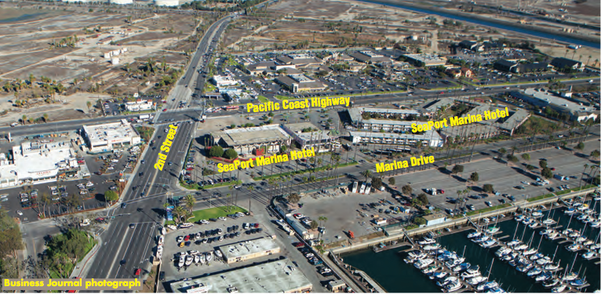A long sought-after proposal to transform prime waterfront property at 2nd Street and Pacific Coast Highway (PCH) is being revised while the city and community members are working to establish new land use guidelines to reframe future development in Southeast Long Beach.
Over the past several years, attempts by property owner Raymond Lin of Taki-Sun to redevelop the 11-acre SeaPort Marina Hotel property have failed to move forward because of concerns raised by residents and environmental groups about plans for residential high-rise buildings and potential impacts the development would have on traffic and the nearby Los Cerritos Wetlands.
A newly revised project, however, is in the works, Alex Cherin, spokesperson for the project, told the Business Journal. More details about the revised project and its new environmental impact report (EIR) will be made available next month, he said in an e-mail.

“The project development team is still working on various options for the site,” Cherin said. “We also continue to work with city staff on finalizing the EIR for any potential development.”
He added that the new project would be consistent with the city’s existing zoning under the Southeast Area Development and Improvement Plan (SEADIP), zoning guidelines established nearly 40 years ago that allow only commercial use.
After ditching plans that once called for a 12-story condominium complex, the property owner submitted a proposal nearly two years ago for an all-commercial development to be called The Shoppes at 2nd + PCH, with one- and two-story buildings for retail and restaurant space.
At the same time, as a way to strike a balance between the needs of economic development and environmental preservation, the city launched a comprehensive effort to update zoning of the area by collaborating with local stakeholders, including residents, environmental groups, property owners and developers.
Last month, the city took a step forward in that effort, releasing a draft-specific plan to update SEADIP, which was originally written in 1977. Nearly 130 people attended an open house at the Best Western Golden Sails Hotel where community members provided input on the new land-use plan called the Southeast Area Specific Plan (SEASP).
Advance Planning Officer Christopher Koontz said in a phone interview that a major change from the old plan is that the new guidelines will allow for a mix of land uses, allowing for residential, commercial and hotel development.
The new plan also increases the maximum height for buildings from 35 feet to five stories, he said, adding that the new allowable building height will provide the “right balance” for economic development and environmental preservation to thrive.
“The fact is you can’t really get a good mix of uses without a little bit more height,” Koontz said. “At five stories, you’re not talking about blocking views or any other detrimental impacts, and we think that’s the right balance for the site.”
Seven-story buildings will also be allowed in some areas but only for new structures with public amenities and that don’t take up more than 25 percent of a project site, he said.
The main goal of creating the specific plan is to improve the aesthetics and economic vitality of the southeast area, including the Golden Sails Hotel site, the Marina Pacifica Mall, 2nd Street and PCH, and the Marketplace Long Beach shopping center, where development has stagnated for decades.
Koontz said the plan calls for development that would create a more “walkable” area for the public, with bike paths, landscaping and wetlands conservation opportunities. While buildings will be taller, new structures are required to be oriented in a way that takes advantage of the waterfront with views of the marina, unlike existing commercial structures, he said.
“What we heard from the community and leaders here in the city is that they wanted something more walkable and wanted something that created new investment to try to reconnect with the water,” Koontz said. “The existing development kind of turns its back on the water. When you go to Best Buy you have no idea that there’s a beautiful waterfront marina behind it.”
The Los Cerritos Wetlands Land Trust (LCWLT), which has been a strong opponent to development at 2nd Street and PCH, stated in an e-mail that the group is relatively pleased with the specific plan but still has concerns about how residential development will ultimately impact traffic and the wetlands habitat.
LCWLT stated that more than 5,000 residential units at build-out by 2035 would be permitted for the area under the new plan, adding that the land trust is “concerned that roads through wetlands will once again be proposed as a way to alleviate traffic.”
The city will be accepting public comments on the draft specific plan through the end of this April, Koontz said. After reviewing comments and making adjustments to the plan, the city will release a draft EIR on the SEASP in late May or early June.
